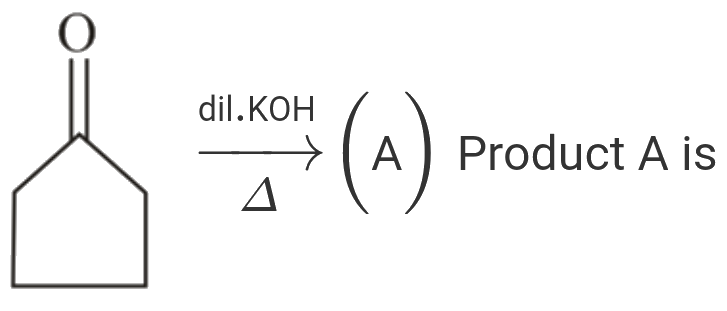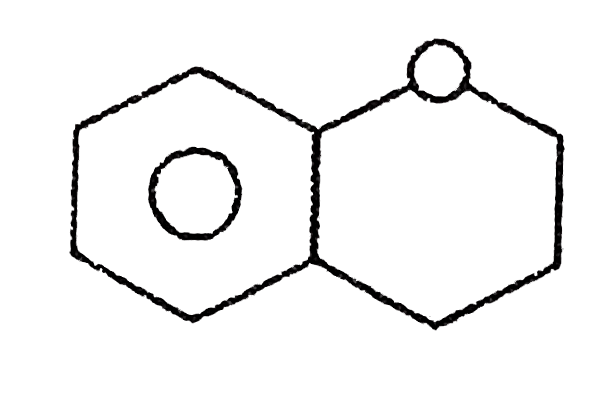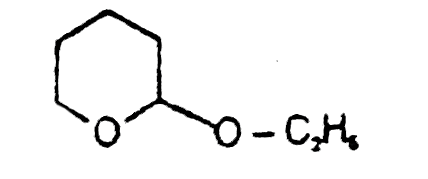PhOH+CHCl3Sodium−−−−−→Hydroxide product. The product on acidic hydrolysis gives :
Benzoic acid
Salicylaldehyde
Salicylic acid
Phenol
The correct Answer is:B
To solve the problem, we need to analyze the reaction between phenol (PhOH) and chloroform (CHCl₃) in the presence of sodium hydroxide (NaOH), followed by acidic hydrolysis of the product formed.
1. Identify the Reactants:
- The reactants are phenol (PhOH) and chloroform (CHCl₃) in the presence of sodium hydroxide (NaOH).
2. Reaction Mechanism:
- Sodium hydroxide acts as a base and abstracts a proton (H⁺) from phenol, generating a phenoxide ion (PhO⁻).
- The phenoxide ion is a good nucleophile and can attack the electrophilic carbon in chloroform, which has three chlorine atoms attached.
3. Formation of the Intermediate:
- The attack of the phenoxide ion on chloroform leads to the formation of a carbene intermediate (CCl₂), which is a neutral species with a valence of 2.
- This carbene can react further to form a product.
4. Formation of Salicylate:
- The phenoxide ion attacks the carbene, resulting in the formation of a compound where the phenolic group is ortho to the carbene (CCl₂) group, leading to the formation of ortho-chlorophenol.
5. Acidic Hydrolysis:
- The product formed (ortho-chlorophenol) undergoes acidic hydrolysis. In this step, the chlorine atom acts as a good leaving group.
- The acidic conditions facilitate the removal of the chlorine atom, leading to the formation of salicylic acid (C₇H₆O₃).
6. Final Product:
- The final product after acidic hydrolysis is salicylic acid (C₇H₆O₃).
Final Answer:
The product of the reaction of phenol with chloroform in the presence of sodium hydroxide, followed by acidic hydrolysis, is salicylic acid (C₇H₆O₃).
---
- The reactants are phenol (PhOH) and chloroform (CHCl₃) in the presence of sodium hydroxide (NaOH).
- Sodium hydroxide acts as a base and abstracts a proton (H⁺) from phenol, generating a phenoxide ion (PhO⁻).
- The phenoxide ion is a good nucleophile and can attack the electrophilic carbon in chloroform, which has three chlorine atoms attached.
- The attack of the phenoxide ion on chloroform leads to the formation of a carbene intermediate (CCl₂), which is a neutral species with a valence of 2.
- This carbene can react further to form a product.
- The phenoxide ion attacks the carbene, resulting in the formation of a compound where the phenolic group is ortho to the carbene (CCl₂) group, leading to the formation of ortho-chlorophenol.
- The product formed (ortho-chlorophenol) undergoes acidic hydrolysis. In this step, the chlorine atom acts as a good leaving group.
- The acidic conditions facilitate the removal of the chlorine atom, leading to the formation of salicylic acid (C₇H₆O₃).
- The final product after acidic hydrolysis is salicylic acid (C₇H₆O₃).
The product of the reaction of phenol with chloroform in the presence of sodium hydroxide, followed by acidic hydrolysis, is salicylic acid (C₇H₆O₃).
Topper's Solved these Questions
- BOOK - VMC MODULES ENGLISHCHAPTER - ALCOHOLS, PHENOLS & ETHERSEXERCISE - Efficient98videos
ALCOHOLS, PHENOLS & ETHERS
- BOOK - VMC MODULES ENGLISHCHAPTER - ALCOHOLS, PHENOLS & ETHERSEXERCISE - Impeccable100videos
ALCOHOLS, PHENOLS & ETHERS
- BOOK - VMC MODULES ENGLISHCHAPTER - ALCOHOLS, PHENOLS & ETHERSEXERCISE - Impeccable100videos
ALCOHOLS, PHENOLS & ETHERS
- BOOK - VMC MODULES ENGLISHCHAPTER - ALCOHOLS, PHENOLS & ETHERS EXERCISE - IN-CHAPTER EXERCISE - L10videos
ALCOHOLS, PHENOLS & ETHERS
- BOOK - VMC MODULES ENGLISHCHAPTER - ALDEHYDES,KETONES & CARBOXYLIC ACIDS EXERCISE - IN-CHAPTER EXERCISE-M10videos
ALDEHYDES,KETONES & CARBOXYLIC ACIDS
Similar Questions
Knowledge Check
- Question 1 - Select One
cis-2-buteneHBr−−−−−→Peroxide product , Product of the reaction is :
ARacemicBDiastereomersCMesoDE and Z isomer
CH3D+Cl2hv−−−−→(1 mole) Product
The product isView Solution dil.KOH−−−−→Δ(A) Product A is View Solution
dil.KOH−−−−→Δ(A) Product A is View SolutionCH3−CH3| C | CH3−COOH+Br2Red P−−→[Product]
The product of the above reaction is -View Solution NaNO2−−−−→HCl product?View Solution
NaNO2−−−−→HCl product?View SolutionCH3CH2CH2Cl+CH3C∣ClHCH3Na−−−−→dry ether Products.
Which of te following is not a product of above reaction?View Solution HI−−−−→low temp product areView Solution
HI−−−−→low temp product areView SolutionSodium benzene sulphonate reacts with NaOH and then on acidic hydrolysis, it gives:
View Solution



